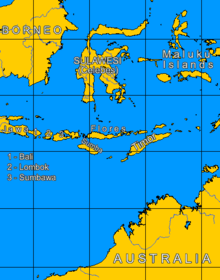Native name:
| |
|---|---|
 | |
| Geography | |
| Location | Southeast Asia |
| Coordinates | 9°00′S 120°00′E / 9.000°S 120.000°E |
| Archipelago | Sunda Islands |
| Total islands | 975 |
| Major islands | Bali, Lombok, Sumbawa, Sumba, Flores, Timor |
| Highest elevation | 3,726 m (12224 ft) |
| Highest point | Mount Rinjani |
| Demographics | |
| Ethnic groups | Balinese, Sasak, Sumbawan, Bimanese, Atoni, Manggaraian, Sumbese, Lamaholot, Tetum, Mambai, Kemak, Moluccans, Alfur, Javanese, Bugis, Bali Aga. |


The Lesser Sunda Islands (Indonesian: Kepulauan Sunda Kecil, Tetum: Illá Sunda ki'ik sirá, Balinese: Kapuloan Sunda cénik), now known as Nusa Tenggara Islands (Indonesian: Kepulauan Nusa Tenggara, or "Southeast Islands"),[1] are an archipelago in Indonesian archipelago. Most of the Lesser Sunda Islands are located within the Wallacea region, except for the Bali province which is west of the Wallace Line and is within the Sunda Shelf. Together with the Greater Sunda Islands to the west, they make up the Sunda Islands. The islands are part of a volcanic arc, the Sunda Arc, formed by subduction along the Sunda Trench in the Java Sea. In 1930 the population was 3,460,059;[2] today slightly over 15.5 million people live on the islands. Etymologically, Nusa Tenggara means "Southeast Islands" from the words of nusa which means 'island' from Old Javanese language and tenggara means 'southeast'.
The main Lesser Sunda Islands are, from west to east: Bali, Lombok, Sumbawa, Flores, Sumba, Savu, Rote, Timor, Atauro, Alor archipelago, Barat Daya Islands, and Tanimbar Islands. Apart from the eastern half of Timor island and Atauro island which constitute the nation of Timor Leste, all the other islands are part of Indonesia.
- ^ "Badak Sunda dan Harimau Sunda". "[...] Mr. M. Yamin yang pada 1950-an ketika menjadi Menteri P.P. dan K. mengganti istilah Kepulauan Sunda Kecil menjadi Kepulauan Nusa Tenggara. Sebab, istilah Kepulauan Sunda Kecil diganti dengan Kepulauan Nusa Tenggara, maka istilah Kepulauan Sunda Besar juga tidak lagi digunakan dalam ilmu bumi dan perpetaan nasional Indonesia – meskipun dalam perpetaan Internasional istilah Greater Sunda Islands dan Lesser Sunda Islands masih tetap digunakan." – Ajip Rosidi: Penulis, budayawan. Pikiran Rakyat, 21 August 2010. Archived from the original on 8 July 2015. Retrieved 7 July 2015.
- ^ Nitisastro, Widjojo (2006). Population Trends in Indonesia (1st publication 1970, Cornell University Press). Equinox Publishing. p. 75. ISBN 978-979-3780-43-6. OCLC 86608.